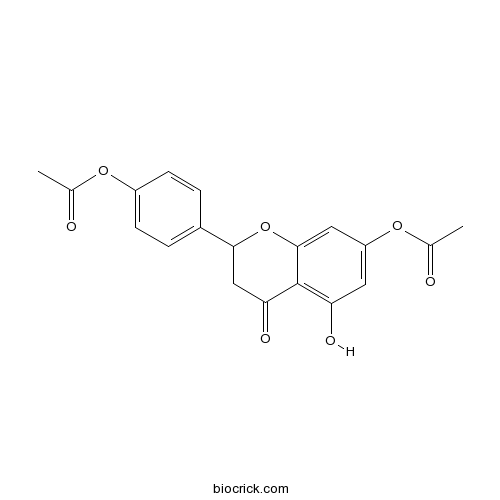Naringenin-4',7-diacetateCAS# 18196-13-9 |

Quality Control & MSDS
3D structure
Package In Stock
Number of papers citing our products

| Cas No. | 18196-13-9 | SDF | Download SDF |
| PubChem ID | 3870517 | Appearance | Powder |
| Formula | C19H16O7 | M.Wt | 356.3 |
| Type of Compound | Flavonoids | Storage | Desiccate at -20°C |
| Solubility | Soluble in Chloroform,Dichloromethane,Ethyl Acetate,DMSO,Acetone,etc. | ||
| Chemical Name | [4-(7-acetyloxy-5-hydroxy-4-oxo-2,3-dihydrochromen-2-yl)phenyl] acetate | ||
| SMILES | CC(=O)OC1=CC=C(C=C1)C2CC(=O)C3=C(C=C(C=C3O2)OC(=O)C)O | ||
| Standard InChIKey | PPTNIBIWQQIJJN-UHFFFAOYSA-N | ||
| Standard InChI | InChI=1S/C19H16O7/c1-10(20)24-13-5-3-12(4-6-13)17-9-16(23)19-15(22)7-14(25-11(2)21)8-18(19)26-17/h3-8,17,22H,9H2,1-2H3 | ||
| General tips | For obtaining a higher solubility , please warm the tube at 37 ℃ and shake it in the ultrasonic bath for a while.Stock solution can be stored below -20℃ for several months. We recommend that you prepare and use the solution on the same day. However, if the test schedule requires, the stock solutions can be prepared in advance, and the stock solution must be sealed and stored below -20℃. In general, the stock solution can be kept for several months. Before use, we recommend that you leave the vial at room temperature for at least an hour before opening it. |
||
| About Packaging | 1. The packaging of the product may be reversed during transportation, cause the high purity compounds to adhere to the neck or cap of the vial.Take the vail out of its packaging and shake gently until the compounds fall to the bottom of the vial. 2. For liquid products, please centrifuge at 500xg to gather the liquid to the bottom of the vial. 3. Try to avoid loss or contamination during the experiment. |
||
| Shipping Condition | Packaging according to customer requirements(5mg, 10mg, 20mg and more). Ship via FedEx, DHL, UPS, EMS or other couriers with RT, or blue ice upon request. | ||

Naringenin-4',7-diacetate Dilution Calculator

Naringenin-4',7-diacetate Molarity Calculator
| 1 mg | 5 mg | 10 mg | 20 mg | 25 mg | |
| 1 mM | 2.8066 mL | 14.0331 mL | 28.0662 mL | 56.1325 mL | 70.1656 mL |
| 5 mM | 0.5613 mL | 2.8066 mL | 5.6132 mL | 11.2265 mL | 14.0331 mL |
| 10 mM | 0.2807 mL | 1.4033 mL | 2.8066 mL | 5.6132 mL | 7.0166 mL |
| 50 mM | 0.0561 mL | 0.2807 mL | 0.5613 mL | 1.1226 mL | 1.4033 mL |
| 100 mM | 0.0281 mL | 0.1403 mL | 0.2807 mL | 0.5613 mL | 0.7017 mL |
| * Note: If you are in the process of experiment, it's necessary to make the dilution ratios of the samples. The dilution data above is only for reference. Normally, it's can get a better solubility within lower of Concentrations. | |||||

Calcutta University

University of Minnesota

University of Maryland School of Medicine

University of Illinois at Chicago

The Ohio State University

University of Zurich

Harvard University

Colorado State University

Auburn University

Yale University

Worcester Polytechnic Institute

Washington State University

Stanford University

University of Leipzig

Universidade da Beira Interior

The Institute of Cancer Research

Heidelberg University

University of Amsterdam

University of Auckland

TsingHua University

The University of Michigan

Miami University

DRURY University

Jilin University

Fudan University

Wuhan University

Sun Yat-sen University

Universite de Paris

Deemed University

Auckland University

The University of Tokyo

Korea University
- Fmoc-Dap-OH
Catalog No.:BCC3187
CAS No.:181954-34-7
- Sequirin C
Catalog No.:BCN4688
CAS No.:18194-29-1
- DLPC
Catalog No.:BCC7929
CAS No.:18194-25-7
- KC 12291 hydrochloride
Catalog No.:BCC7618
CAS No.:181936-98-1
- Crotonoside
Catalog No.:BCN6281
CAS No.:1818-71-9
- 25-Anhydrocimigenol 3-O-beta-D-xyloside
Catalog No.:BCN3436
CAS No.:181765-11-7
- (-)-beta-Pinene
Catalog No.:BCN3857
CAS No.:18172-67-3
- Cyclopiazonic acid
Catalog No.:BCC6981
CAS No.:18172-33-3
- Interiotherins A
Catalog No.:BCN3093
CAS No.:181701-06-4
- Valdecoxib
Catalog No.:BCC4441
CAS No.:181695-72-7
- SB 228357
Catalog No.:BCC7036
CAS No.:181629-93-6
- tert-Butyldimethylsilyl Chloride
Catalog No.:BCC2796
CAS No.:18162-48-6
- Angenomalin
Catalog No.:BCN8246
CAS No.:18199-64-9
- Ethyl beta-D-fructofuranoside
Catalog No.:BCN1145
CAS No.:1820-84-4
- BL 1249
Catalog No.:BCC7777
CAS No.:18200-13-0
- Meliasendanin D
Catalog No.:BCN7610
CAS No.:1820034-05-6
- KB-R7943 mesylate
Catalog No.:BCC1676
CAS No.:182004-65-5
- 6-Angeloyloxyditropan-3-yl itaconate
Catalog No.:BCN1867
CAS No.:182015-05-0
- Nitrosostromelin
Catalog No.:BCN1745
CAS No.:182064-61-5
- Quinovic acid 3-O-(3',4'-O-isopropylidene)-beta-D-fucopyranoside
Catalog No.:BCN1519
CAS No.:182132-59-8
- Nyssoside
Catalog No.:BCN1146
CAS No.:182138-70-1
- 3,4-seco-Olean-12-en-4-ol-3,28-dioic acid
Catalog No.:BCN7151
CAS No.:182249-69-0
- Clausine I
Catalog No.:BCN4687
CAS No.:182261-94-5
- Lirioprolioside B
Catalog No.:BCN2740
CAS No.:182284-68-0
Toxicity and cell cycle effects of synthetic 8-prenylnaringenin and derivatives in human cells.[Pubmed:15051922]
Pharmacology. 2004 May;71(1):46-56.
The estrogenic flavanone rac-8-prenylnaringenin (8-PN) and 3 derivatives (rac-7-(O-prenyl)naringenin-4'-acetate (7-O-PN), rac-5-(O-prenyl)naringenin-4',7-diacetate (5-O-PN), and rac-6-(1,1-dimethylallyl)naringenin (6-DMAN) were prepared by chemical synthesis and analyzed with respect to their toxicity and possible cell cycle effects in human acute myeloid leukemia (HL-60) cells. With the exception of 5-O-PN, all the other naringenins showed only weak toxic effects at concentrations below 50 micromol/l. A cell cycle analysis over several cell generations up to 4 days was carried out using the fluorescent dye carboxyfluorescein diacetate N-succinimidyl ester (CFSE) followed by propidium iodide (PI) staining at the end of the experiment. The well-studied flavonol quercetin was included in the analysis as a reference substance. All flavonoids affected cell proliferation, but the extent and the resulting changes in the proliferation pattern were specific for each substance. In contrast to the radical scavenging activity of quercetin, the tested flavanones showed no anti-oxidative properties using several different test systems. Similarly, the mitochondrial membrane potential (DeltaPsim) was hardly effected by these compounds, while both menadione and quercetin strongly reduced the potential after 1 h of treatment. The reported chemical modification of interesting lead substances (like the strongly estrogenic 8-PN) presents a promising approach to modulate the properties of a relevant substance in a pharmacologically desirable way. The low toxicity and weak cytostatic properties of the tested naringenin derivatives is encouraging for further studies on known naringenin target molecules.


